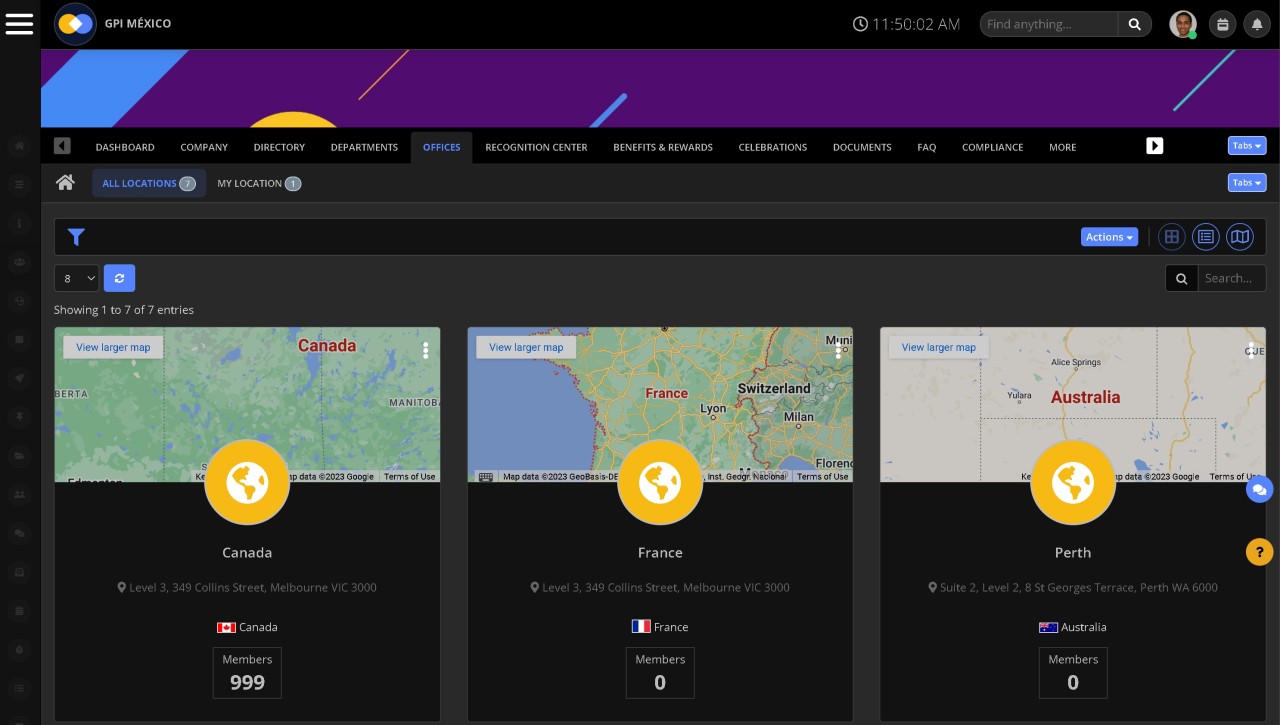Insight Blog
Agility’s perspectives on transforming the employee's experience throughout remote transformation using connected enterprise tools.
10 minutes reading time
(1935 words)
The Benefits Of a Cloud-Based Intranet Solutions
We'll be unpacking some of the other primary selling points of these intranet solutions below to help business owners finetune their own investments in their intranet and other digital infrastructure.
Setting up an enterprise intranet for your business is perhaps one of the best methods for keeping track of company records and resources.
A company intranet also establishes your business as a fixture of its industry, setting a good first impression for new employees and providing existing employees with solid digital infrastructure that supports them through the workday.
And with the rise of cloud computing, the benefits of business intranet systems have only grown tenfold.
Alongside maintaining a centralized portal for accessing company resources, cloud-based intranet solutions also offer the additional advantage of providing this solution without the need for little to no on-site infrastructure.
But the benefits of cloud-based intranets don't just stop there.
We'll be unpacking some of the other primary selling points of these intranet solutions below to help business owners finetune their own investments in their intranet and other digital infrastructure.
Try AgilityPortal for 14 days Free, No credit card required: Cloud-Based Intranet Solutions
Provides Ultra flexible scalability
Thanks to cloud cost optimization services, it's actually easier now than ever before to keep your cloud-based intranet as agile as you need it to be.
With AI-driven cloud cost optimization capabilities at your fingertips, you can assess all the components of your cloud set-up in order to swiftly identify optimization opportunities.
This added level of control over your cloud-based intranet also paves the way for a truly game-changing capability: instant scalability.
In simpler terms, business managers can easily adapt their cloud-based digital infrastructure to accommodate whole departments of new staff members as well as a slew of new business apps, with just a few clicks and quick amendments to their Kubernetes containers.
Ultra flexible system scalability allows business owners the freedom to grow their enterprise without concerns for their network's capacity.
Because that capacity can easily be amended with a minimal buffer time. And cloud cost optimization services will of course, also ensure that the upscaling or downscaling of your cloud-based intranet solution is conducted at a minimal cost every single time.
Cloud-Based Intranet Solutions are quick to deploy
Establishing an on-premise intranet entails extensive time and preparation.
Adequate hardware needs to be procured, and any inadequate components must be upgraded or replaced. The IT team invests considerable effort into configuring, testing, and deploying the intranet. Additionally, depending on the chosen solution, substantial customization and design work may be necessary before launching the intranet.
In contrast, cloud-based intranets offer a quicker setup process, often taking just a few weeks if clear requirements are defined in advance. As the intranet is managed by a third party, the technical aspects are typically handled externally.
This means that the responsibility of intranet launch can be delegated to the HR or internal communications team, alleviating the need for extensive involvement from the IT department.
By opting for a cloud-based intranet, organizations can significantly streamline the setup phase, reducing the burden on internal resources.
With a clear understanding of their requirements, companies can expedite the implementation process and benefit from a faster deployment, allowing them to leverage the advantages of an intranet solution more quickly and efficiently.
Cloud-based intranets are automatically updated
Ensuring that computer systems operate at their optimal level requires regular updates. However, when relying on a self-hosted, on-premise intranet solution, this responsibility falls on the IT team, posing significant challenges. Updating such systems can disrupt work if performed during working hours, and even minor errors can result in major complications.
In contrast, cloud intranet solutions offer the advantage of automatic updates that can be seamlessly rolled out with minimal disruption.
As these updates are managed by the intranet provider, organizations can avoid the burden of manual updates and the associated risks.
So the data stored on the intranet is typically backed up on the provider's servers, alleviating concerns about data loss.
Selecting a cloud intranet solution, companies can simplify the update process, ensuring that their intranet remains up to date without causing significant interruptions or requiring extensive IT involvement.
This enables employees to continue their work uninterrupted, while also benefiting from the added assurance of data backup provided by the intranet provider's infrastructure.
Free E-Book: How To Get Your Intranet Off The Ground
Cloud intranets can be accessed from anywhere at anytime
One significant outcome of recent years is the increasing trend of companies granting their employees the flexibility to work from various locations of their choice. This could include the office, home, public coworking spaces, or even the picturesque beach (although we advise against it unless you enjoy sandy keyboards).
Regardless of the location, these employees require seamless access to the same files, documents, and information as they did when they were based solely at the company headquarters. Furthermore, they need efficient means of communication and collaboration with their colleagues, regardless of physical distance.
By utilizing a cloud-based intranet, particularly one that offers a user-friendly mobile app, employees can:
- Engage in real-time communication from anywhere.
- Read, share, and post updates on the go.
- Work productively and effectively in their preferred work environment.
In contrast, accessing a traditional on-premise intranet from home would typically require navigating complex VPN tokens or setting up unreliable remote access, assuming it is even feasible in the first place.
Embracing a cloud-based intranet empowers organizations to embrace remote work by providing employees with the necessary tools to stay connected and engaged, regardless of their physical location.
It eliminates the barriers posed by traditional intranet access methods, allowing for seamless communication, collaboration, and productivity from any remote setting.
Additional network security
One of the main disadvantages of a self-hosted intranet is that all of your infrastructure is basically available on-site or within your business premises. Not only does this cut down on your available work space, but it also raises some serious security risks.
For starters, having an on-premise intranet opens up the possibility of third parties gaining access to your networking hardware.
From here, your organization can become vulnerable to aggressive cyber attacks, jeopardizing both your sensitive company data.
With a cloud-based intranet solution, however, you can enjoy the security offerings provided by your selected cloud system.
But how exactly do you assess the security offerings of all your shortlisted cloud service providers?
We recommend searching through their website for a few noteworthy certificates, including an ISO/IEC 27001 certification as well as mention of compliance with SOC Type 2 standards.
The former is an information security standard developed in tandem with both the International Organization for Standardization and the International Electrotechnical Commission, and the latter is a voluntary compliance standard developed by the AICPA (American Institute of CPAs) which outlines how organizations should responsibly manage their customer data.
Providers that offer security reporting services will also prove themselves to be a highly valuable asset.
Access to cloud support services
Speaking of reporting services, one of the other key advantages of managing a cloud-based intranet rather than setting up a fully on-premise intranet is the opportunity to take advantage of all the SaaS (or 'software as a service') support services available through your selected provider.
It's common for cloud platforms to offer their customers a wide range of different network support services, including cloud migration and integration assistance amongst a handful of other tailored or provider-specific extras.
A cloud provider will likely be able to set up all your applications for you, allowing you to do away with all the nitty gritty aspects of setting up a Google Workspace or Office 365 system and outlining how they should ideally interact with all of your other apps.
This is the magic of cloud integration. And trust us when we say that you will never want to return to a self-managed intranet after experiencing the efficiency of this particular cloud support service.
And if you're planning to move your intranet from a self-managed set-up to a cloud platform, your cloud provider should be able to offer some much-needed assistance with this cloud migration as well.
The same goes for any business owners looking to maintain a hybrid intranet system, this being an intranet that utilizes both on-site and cloud infrastructure.
Supports a remote or hybrid workforce
Moving onto another type of 'hybrid model' now, it's no secret that millions of companies across the globe have dramatically altered the way they operate in recent years. Following on from the COVID-19 pandemic, many businesses have opted to retain remote and hybrid working opportunities for their employees.
Whilst this provides staff with more flexibility and added control over their own work/life balance, remote and hybrid work models do pose a novel challenge for business owners. How do you provide a secure company intranet for an increasingly remote workforce?
The answer lies in ensuring that your intranet system is both secure and agile.
It could honestly be argued that the shift towards hybrid and remote work models is what really segmented cloud-based intranets as the preferred solution for many businesses today.
Maintaining the option to provide a secure cloud-based intranet to both on-site workers as well as employees who are working from home or perhaps even working abroad, can help business owners keep a strong, experienced, and equipped body of staff.
And as any seasoned business manager knows, a capable workforce is the best foundation for any thriving business.
Lower upfront costs
When considering the implementation of a new intranet solution, cost becomes a major factor for organizations.
Limited internal communications budgets often require collaboration with IT and HR departments to initiate any progress. However, intranet projects frequently face delays of months or even years as company decision-makers debate the associated expenses.
The truth is, deploying an intranet can be exorbitantly expensive. On-premise intranets place a significant burden on internal servers, necessitating costly upgrades or replacements. Moreover, there are expenses related to installation, configuration, and software testing, as well as ongoing maintenance and support. Training programs must be developed to ensure employees are proficient in using the new platform, adding further costs.
Additionally, companies tend to overlook the impact on electricity consumption, which can significantly contribute to monthly bills and pose environmental concerns for corporate social responsibility reports.
In contrast, cloud-based intranet solutions offer a more straightforward cost structure.
While there may be an initial investment to launch the intranet, it pales in comparison to the substantial sums required for establishing an entire server infrastructure to support the software. Subsequently, all other expenses are covered through a predictable monthly subscription fee, eliminating unexpected costs.
By opting for a cloud-based intranet, organizations can simplify their financial outlook, reduce infrastructure expenses, and enjoy the flexibility of a subscription-based model.
This allows companies to allocate their resources efficiently and prioritize their budgets without compromising the implementation and utilization of a robust intranet system.
How Much Does a Cloud-Based Intranet Solutions Cost
Wrapping up
Nowadays, investing in a cloud-based intranet solution has become a standard for business owners operating out of a range of different industries.
From the healthcare sector to finance and everything in between, cloud-based intranets are enjoyed for their streamlined set-up, superior security, and exceptional scalability.
Be sure to conduct independent research into cloud-based intranet solutions for yourself to determine whether an investment in cloud infrastructure is the right choice for your business.
Categories
Blog
(2600)
Business Management
(319)
Employee Engagement
(207)
Digital Transformation
(173)
Intranets
(119)
Growth
(118)
Remote Work
(61)
Sales
(48)
Collaboration
(37)
Culture
(29)
Project management
(29)
Customer Experience
(26)
Knowledge Management
(21)
Leadership
(20)
Comparisons
(5)
Ready to learn more? 👍
One platform to optimize, manage and track all of your teams. Your new digital workplace is a click away. 🚀
Free for 14 days, no credit card required.
















